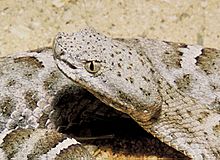Toxicoferans facts for kids
Quick facts for kids Toxicofera |
|
|---|---|
 |
|
| Venomous snakes, such as the rattlesnake shown above, are the most well-known venomous squamates. | |
| Scientific classification | |
| Kingdom: | |
| Phylum: | |
| Subphylum: | |
| Class: | |
| Subclass: | |
| Infraclass: | |
| Superorder: | |
| Order: | |
| (unranked): |
Toxicofera
|
Toxicofera is a scientific name for a large group of living Squamata. This group includes many different kinds of lizards and snakes. The name "Toxicofera" comes from Greek or Latin words. It means "those who carry toxins."
This group is special because it includes all known venomous reptile species. It also includes many related species that are not venomous. Scientists believe that the ability to make venom might have developed only once in the history of these animals. This happened a very long time ago.
Contents
What are Toxicofera?
Toxicofera is a "clade." In science, a clade is a group of living things that all came from a single common ancestor. Scientists use this idea to understand how different animals are related. For Toxicofera, it means all the animals in this group share a common ancestor that lived millions of years ago.
The Idea of Venom Evolution
For a long time, scientists thought that venom in reptiles developed many times. But new research suggests something different. It shows that the ability to produce venom might have appeared only once. This happened in a very early ancestor of all Toxicofera. Over time, some of these animals kept their venom, while others lost it. This idea helps us understand how these diverse reptiles are connected.
Animals in the Toxicofera Group
The Toxicofera group brings together several well-known reptile types. These groups were traditionally classified differently. But now, based on new scientific findings, they are seen as part of this larger Toxicofera clade.
Snakes (Serpentes)
This suborder includes all snakes. Snakes are legless reptiles known for their long bodies. Many snakes are venomous, like rattlesnakes and cobras. However, many other snakes, like boa constrictors and pythons, are not venomous. They are still part of the Toxicofera group because they share a common ancestor with venomous snakes.
Iguanas and Chameleons (Iguania)
The Iguania suborder includes many familiar lizards. This includes iguanas, which are often found in tropical areas. It also includes agamid lizards, like bearded dragons. And of course, chameleons, famous for changing their color. Most of these lizards are not venomous. But they are still part of Toxicofera. This is because their ancestors were part of the group where venom first appeared.
Monitor Lizards and Gila Monsters (Anguimorpha)
The Anguimorpha group contains some very interesting lizards.
Monitor Lizards (Varanidae)
This family includes monitor lizards. These are often large, powerful lizards. The Komodo dragon is the largest living monitor lizard. Some monitor lizards produce a mild venom. This venom helps them hunt their prey.
Alligator and Glass Lizards (Anguidae)
The Anguidae family includes alligator lizards and glass lizards. Glass lizards are special because they look like snakes. But they are actually lizards without legs. They can even drop their tails, just like some other lizards. These lizards are not venomous.
Gila Monsters and Beaded Lizards (Helodermatidae)
This family is very important to the Toxicofera idea. It includes the Gila monster and the Mexican beaded lizard. These are two of the few lizards that are known to be venomous. Their venom is used for defense. It also helps them to overpower their prey.

